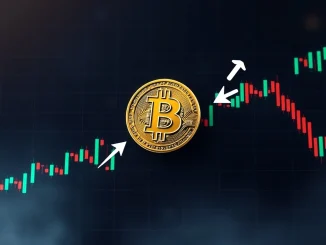
Hold onto your hats, crypto enthusiasts! The Bitcoin rollercoaster is about to get even wilder. In the past week, we’ve witnessed Bitcoin taking a dip of around 4%, and the crypto sphere is buzzing with anticipation – or perhaps anxiety – as markets brace for a major tariff announcement from former U.S. President Trump. Could this be the storm before the calm, or are we heading into a tempest of volatility? Let’s dive into what’s fueling this market uncertainty and what analysts are predicting for Bitcoin in the coming weeks.
Decoding Bitcoin Volatility: Why the Market Jitters?
Bitcoin volatility is no stranger to the crypto market, but recent events have amplified the swings. Several factors are converging to create this atmosphere of uncertainty:
- Inflation Data Reactions: The market is still digesting recent inflation data, which continues to paint a complex picture of the U.S. economy. Persistent inflation concerns often lead to market corrections across various asset classes, including cryptocurrencies.
- Trump’s Tariff Announcement: The biggest immediate trigger is the anticipation surrounding a significant tariff announcement expected from former President Trump. According to reports from The Block, these tariffs may include reciprocal measures, potentially escalating trade tensions globally.
- Market Sentiment and Expectations: Uncertainty breeds volatility. The market is reacting to the *expectation* of these tariffs. If the actual announcement is more aggressive than anticipated, we could see further downward pressure. Conversely, a milder announcement might trigger a relief rally.
In essence, the current cryptocurrency market sentiment is a mix of caution and anticipation. Traders are positioning themselves for potential market-moving news, leading to increased price fluctuations and choppy trading conditions.
Analyst Insights: Navigating the Choppy Waters of BTC Price Prediction
So, what are the experts saying amidst this volatility? Analysts are largely bracing for continued turbulence throughout April. Here’s a snapshot of their BTC price prediction:
| Analyst Outlook | Price Range | Key Factors |
|---|---|---|
| Consolidation Phase | $75,000 – $88,000 | Most analysts expect Bitcoin to consolidate within this range in the short term. This suggests a period of price discovery and market digestion of the current uncertainties. |
| Downside Risks | Below $75,000 (Potential) | Some analysts caution about potential downside if market expectations regarding the tariffs (or other economic factors) are not met. Disappointment could lead to sell-offs. |
| Long-Term Watch: U.S. Strategic Bitcoin Reserve | Uncertain, but Potentially Bullish | The upcoming U.S. Strategic Bitcoin Reserve is highlighted as a longer-term factor to monitor. While its immediate impact is unclear, it represents a significant development in government adoption and could have bullish implications down the line. |
It’s crucial to remember that these are predictions, not guarantees. The cryptocurrency market is inherently unpredictable, and external events can swiftly alter the landscape.
Trump Tariffs: A Black Swan Event for the Cryptocurrency Market?
The looming question is: how significant are these Trump tariffs for Bitcoin and the broader crypto ecosystem? While the direct impact is still unfolding, here are some potential scenarios:
- Market-Wide Risk-Off Sentiment: Tariffs often create economic uncertainty and trade friction. This can trigger a “risk-off” sentiment in global markets. When investors become risk-averse, they tend to move away from volatile assets like cryptocurrencies and towards safer havens.
- Dollar Strength and Bitcoin Weakness (Potentially): Historically, increased tariffs and protectionist trade policies can sometimes strengthen the U.S. dollar. A stronger dollar can, in some instances, exert downward pressure on Bitcoin, especially in the short term.
- Inflationary Pressures (Indirectly): While tariffs are intended to protect domestic industries, they can also lead to higher prices for imported goods, potentially contributing to inflationary pressures. The impact on Bitcoin as an inflation hedge in this specific scenario is complex and debated.
However, it’s not all doom and gloom. Some argue that in the long run, economic uncertainty and potential currency devaluation stemming from trade wars could actually strengthen Bitcoin’s appeal as a decentralized store of value. This is a longer-term narrative that will take time to play out.
Strategic Bitcoin Reserve: A Silver Lining Amidst the Storm?
Amidst the tariff turmoil and market volatility, there’s a potentially significant development on the horizon: the U.S. Strategic Bitcoin Reserve. While details are still scarce, the very idea of a national Bitcoin reserve signals a growing acceptance and strategic consideration of Bitcoin by a major global power.
What could this mean for Bitcoin?
- Validation and Institutional Adoption: A strategic reserve would represent a massive step towards mainstream validation and institutional adoption of Bitcoin. It sends a powerful message that Bitcoin is not just a speculative asset but a strategic one.
- Reduced Supply and Potential Price Appreciation: If the U.S. (or other nations) start accumulating Bitcoin for strategic reserves, it would effectively reduce the available supply in the market. Basic economics suggests that reduced supply with consistent or increasing demand can lead to price appreciation over time.
- Long-Term Bullish Catalyst: While the immediate impact of the reserve is uncertain, it’s widely viewed as a potentially significant long-term bullish catalyst for Bitcoin. It could pave the way for further government and institutional involvement in the crypto space.
It’s important to note that the specifics of the Strategic Bitcoin Reserve – how it will be managed, the size, and the timeline – are still unknown. However, the very concept is a noteworthy development to watch closely.
Navigating Bitcoin’s Volatility: Actionable Insights for Crypto Investors
So, how can you navigate this period of heightened Bitcoin volatility? Here are some actionable insights:
- Stay Informed, Stay Updated: Keep a close eye on market news, especially updates regarding the tariff announcements and macroeconomic data. Knowledge is your best tool in volatile markets.
- Manage Your Risk: Volatility is inherent in crypto. Ensure your portfolio risk is aligned with your risk tolerance. Consider diversification and avoid over-leveraging.
- Dollar-Cost Averaging (DCA): In volatile periods, DCA can be a prudent strategy. Instead of trying to time the market, DCA involves investing a fixed amount at regular intervals, smoothing out your entry price.
- Focus on the Long Term: Remember that Bitcoin and the broader crypto market are still relatively young and prone to volatility. If you believe in the long-term potential of Bitcoin, focus on the bigger picture and avoid being swayed by short-term price swings.
- Secure Your Holdings: With market uncertainty comes potential for increased market activity and scams. Ensure your Bitcoin holdings are securely stored in a reputable wallet, and be extra vigilant against phishing and other scams.
Conclusion: Weathering the Bitcoin Storm
Bitcoin is currently navigating a period of significant volatility, fueled by a combination of macroeconomic factors and the anticipation of Trump’s tariff announcements. Analysts are bracing for choppy trading to continue, with price consolidation expected in the short term. While the tariff situation introduces downside risks and market uncertainty, the emergence of the U.S. Strategic Bitcoin Reserve offers a glimmer of long-term bullish potential.
For crypto investors, the key is to stay informed, manage risk prudently, and maintain a long-term perspective. Volatility is part of the Bitcoin journey. By understanding the factors at play and adopting sound investment strategies, you can navigate these turbulent waters and position yourself for the future of cryptocurrency.



